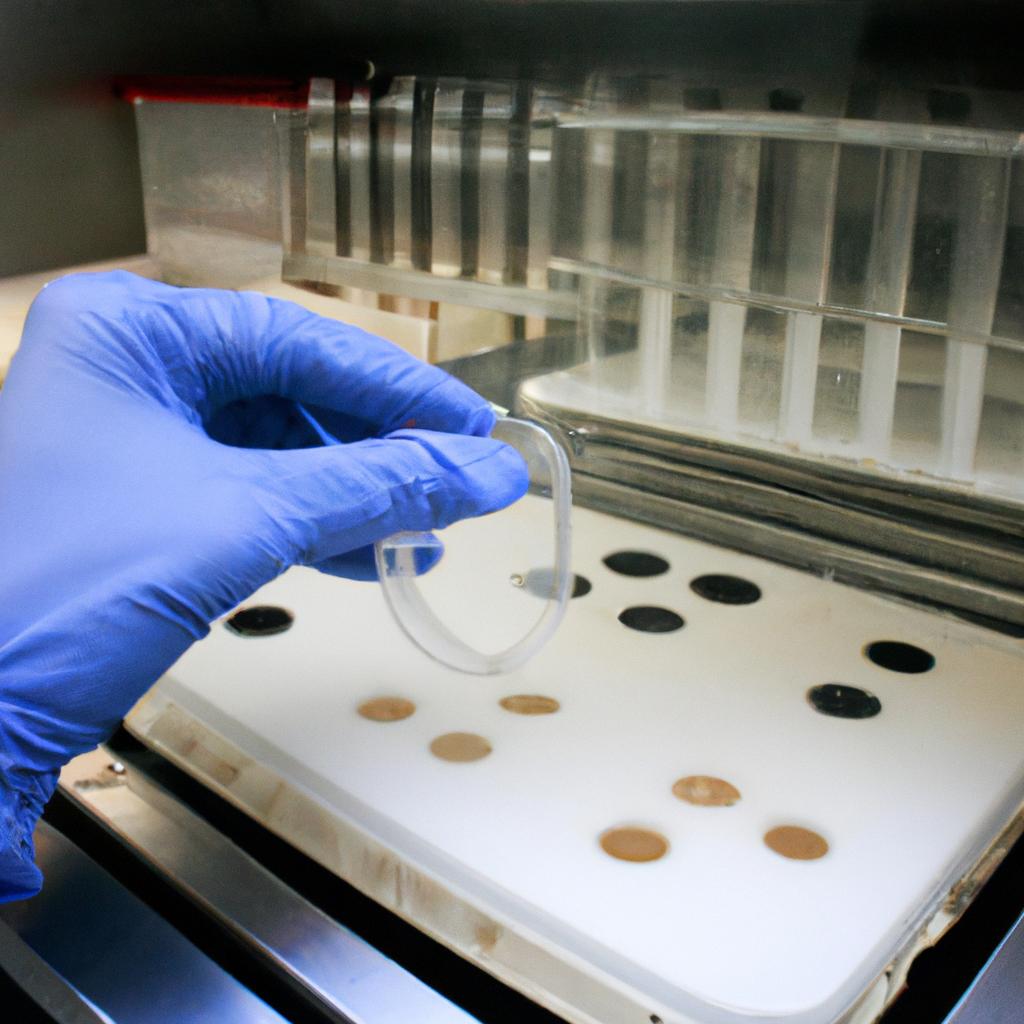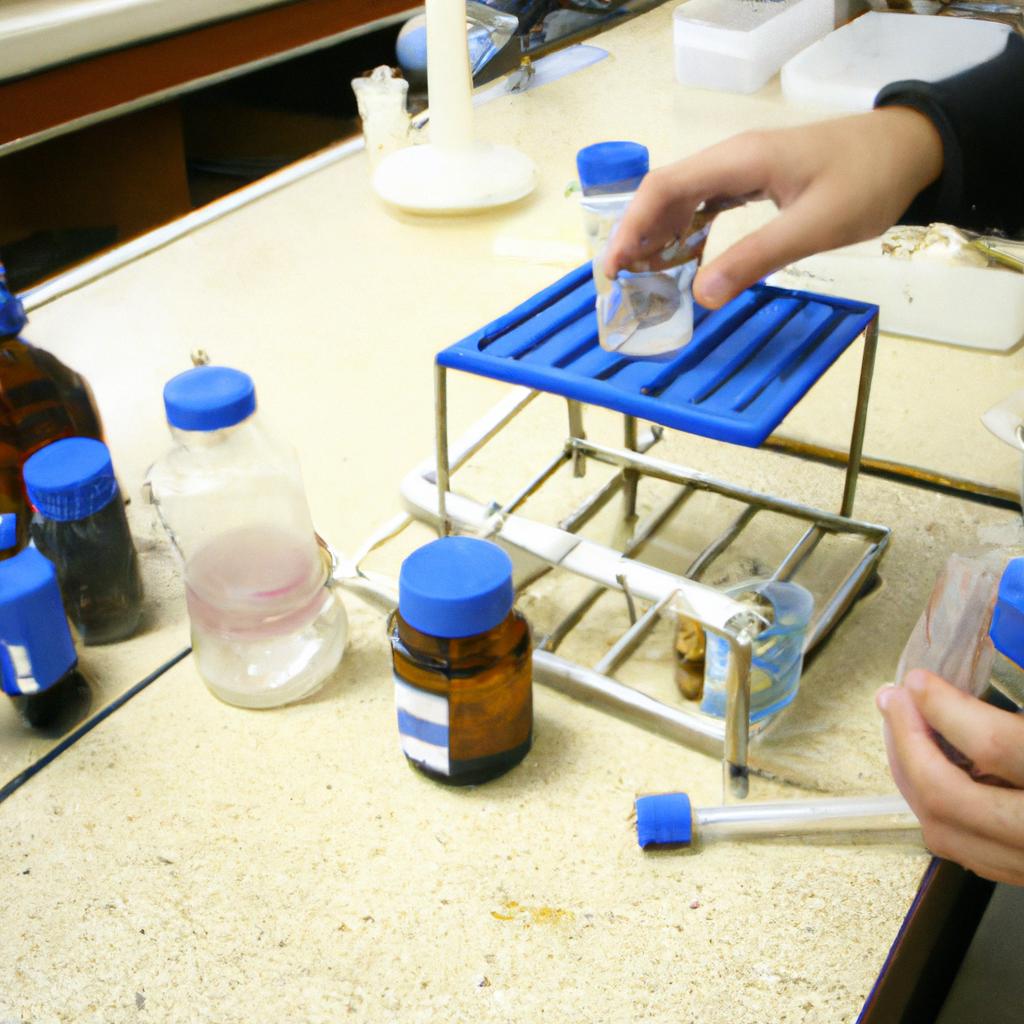Coagulation testing plays a crucial role in veterinary clinical pathology, providing informative insights into the hemostatic status and potential bleeding disorders in animals. By assessing various coagulation parameters, such as clotting times, fibrinogen levels, and platelet counts, veterinarians can obtain valuable information about an animal’s ability to form clots and maintain hemostasis. For instance, consider a hypothetical case of a dog with unexplained episodes of spontaneous bleeding. Through comprehensive coagulation testing, veterinary professionals can identify underlying abnormalities in the coagulation cascade or platelet function that may be contributing to the dog’s condition.
In recent years, advances in technology have led to significant improvements in coagulation testing methods for veterinary medicine. Traditional techniques like prothrombin time (PT) and activated partial thromboplastin time (aPTT) are now complemented by newer assays that provide more detailed information on specific aspects of hemostasis. These include tests for measuring anticoagulant substances like protein C and anti-thrombin III activity, as well as markers of hypercoagulability such as D-dimer levels. With access to a wider range of diagnostic tools, veterinarians can not only diagnose bleeding disorders but also monitor the effectiveness of treatment and evaluate the overall hemostatic status of their patients.
Monitoring the response to treatment is an important aspect of managing bleeding disorders in animals. By regularly assessing coagulation parameters, veterinarians can determine if interventions such as medication or blood transfusions are effectively correcting any underlying abnormalities. This allows for adjustments to be made to the treatment plan as needed, ensuring optimal care for the animal.
Furthermore, comprehensive coagulation testing can help veterinarians evaluate the overall hemostatic status of their patients. By assessing multiple aspects of the coagulation cascade and platelet function, veterinary professionals can gain a more complete understanding of an animal’s ability to form clots and maintain normal hemostasis. This information is particularly valuable in surgical cases or when planning invasive procedures, as it helps identify potential risks and guide decision-making regarding perioperative management.
In summary, advances in coagulation testing methods have greatly enhanced veterinarians’ ability to diagnose bleeding disorders and monitor treatment efficacy in animals. By utilizing a range of assays that assess different components of hemostasis, veterinarians can obtain detailed insights into an animal’s coagulation profile and make informed decisions regarding patient care.
Coagulation testing: Importance in veterinary medicine
Coagulation testing plays a crucial role in veterinary medicine, aiding in the diagnosis and management of various coagulation disorders. By assessing the clotting ability of an animal’s blood, veterinarians can gain valuable insights into potential underlying health conditions. For instance, consider a hypothetical case where a dog presents with unexplained bleeding episodes. Coagulation testing would be essential to identify any abnormalities that may contribute to excessive or prolonged bleeding.
Understanding the importance of coagulation testing requires recognizing its significance in key aspects of veterinary medicine. First and foremost, it enables early detection and monitoring of coagulation disorders, allowing for timely interventions and enhanced patient care. This is particularly relevant when dealing with life-threatening conditions such as hemophilia or disseminated intravascular coagulopathy (DIC).
Moreover, accurate coagulation assessments assist veterinarians in preoperative evaluations by identifying animals at risk for surgical complications related to abnormal clotting mechanisms. Such information helps guide appropriate perioperative management strategies and ensures optimal outcomes for both routine and complex surgical procedures.
To emphasize the impact of coagulation testing on animal welfare, we present a bullet point list highlighting some key benefits:
- Facilitates early identification and treatment of coagulation disorders
- Guides decision-making in surgical interventions
- Enhances overall patient safety during medical procedures
- Improves prognosis and quality of life for affected animals
Furthermore, we provide a table summarizing common laboratory tests used in assessing coagulation status:
| Test | Purpose | Interpretation |
|---|---|---|
| Prothrombin time (PT) | Measures extrinsic pathway activity | Prolonged PT indicates impaired clot formation |
| Activated partial | Evaluates intrinsic pathway function | Prolonged APTT suggests deficiency or inhibition |
| thromboplastin time (APTT) | ||
| Fibrinogen level | Assesses the quantity of fibrinogen in the blood | Decreased levels may indicate liver dysfunction or |
| disseminated intravascular coagulopathy (DIC) | ||
| Platelet count | Determines the number of platelets present | Abnormally low counts suggest thrombocytopenia |
In summary, coagulation testing holds immense value in veterinary medicine. Its role spans from early detection and monitoring of coagulation disorders to guiding surgical interventions and improving patient safety. By incorporating various laboratory tests, veterinarians can assess clotting mechanisms and provide targeted treatment strategies for animals with impaired hemostasis.
Moving forward into the subsequent section on “Common coagulation disorders in animals,” we delve deeper into specific conditions that frequently affect our animal companions.
Common coagulation disorders in animals
Coagulation Testing: Important Considerations and Common Disorders
Case Study:
Consider a hypothetical scenario where a dog is presented to a veterinary clinic with unexplained bruising and prolonged bleeding after minor injuries. The veterinarians suspect an underlying coagulation disorder, emphasizing the significance of accurate coagulation testing in diagnosing such conditions.
Importance of Coagulation Testing:
Accurate evaluation of coagulation parameters plays a critical role in diagnosing and managing various hematological disorders in animals. Proper assessment allows for timely intervention, ensuring optimal patient care. Coagulation tests aid in identifying abnormalities within the blood clotting cascade, enabling clinicians to determine appropriate treatment strategies.
The following bullet points highlight the emotional impact that correct interpretation of coagulation test results can have on both veterinary professionals and pet owners:
- Early detection of coagulation disorders can prevent life-threatening complications.
- Timely diagnosis enables targeted therapies, potentially reducing treatment duration.
- Accurate monitoring during surgical procedures minimizes excessive bleeding risks.
- Effective management enhances overall quality-of-life for affected animals.
Table – Key Coagulation Parameters:
A thorough understanding of key coagulation parameters facilitates comprehensive analysis and interpretation of test results. The table below outlines these essential markers alongside their corresponding functions:
| Parameter | Function |
|---|---|
| Prothrombin Time (PT) | Assesses extrinsic pathway function |
| Activated Partial Thromboplastin Time (aPTT) | Measures intrinsic pathway functionality |
| Fibrinogen Concentration | Evaluates plasma fibrinogen levels |
| Platelet Count | Quantifies platelet numbers |
Transitioning into the subsequent section about “Types of coagulation tests used in veterinary clinical pathology”:
By considering crucial factors like early detection and effective management through proper interpretation, it becomes apparent that utilizing appropriate coagulation tests in veterinary clinical pathology is essential. Understanding the significance of these tests allows us to explore the various types employed to diagnose and monitor coagulation disorders in animals, which will be discussed in detail in the following section.
Types of coagulation tests used in veterinary clinical pathology
Common coagulation disorders in animals can have a significant impact on their overall health and well-being. For instance, let us consider the case of a 6-year-old Labrador Retriever presenting with unexplained bleeding episodes. The dog’s owner noticed prolonged bleeding from minor cuts and bruising even without any trauma. This scenario highlights the importance of accurate coagulation testing in veterinary clinical pathology to diagnose and manage such conditions effectively.
To evaluate an animal’s coagulation status, various types of tests are employed in veterinary clinical pathology. These tests provide valuable insights into the functioning of different components involved in the clotting process. Some commonly used coagulation tests include:
- Activated Partial Thromboplastin Time (aPTT): This test measures intrinsic and common pathway factors’ activity by assessing the time it takes for blood to form a clot after adding specific reagents.
- Prothrombin Time (PT): PT evaluates extrinsic and common pathways by measuring how long it takes for blood to clot after adding tissue factor.
- Platelet Count: This test determines the number of platelets present in a given volume of blood, as these cells play a crucial role in primary hemostasis.
- Fibrinogen Assay: Fibrinogen is essential for clot formation, and this test helps quantify its concentration within the plasma.
Understanding the results obtained from these coagulation tests requires careful interpretation based on established reference ranges or values specific to each species. An abnormal result may indicate underlying coagulopathies, which necessitate further investigation and tailored treatment plans. Additionally, veterinarians must consider other factors that could influence test outcomes, such as concurrent medications or pre-existing medical conditions.
Moving forward to our next section about “Interpretation of coagulation test results,” we will delve deeper into understanding how different abnormalities observed during coagulation testing can aid in diagnosing specific coagulation disorders in animals. By accurately interpreting these results, veterinarians can make informed decisions regarding the appropriate treatment and management strategies for their patients’ coagulopathies.
Now onto “Interpretation of coagulation test results,” we will explore how different abnormalities observed during coagulation testing aid in diagnosing specific coagulation disorders in animals.
Interpretation of coagulation test results
After understanding the types of coagulation tests used in veterinary clinical pathology, it is essential to comprehend the interpretation of their results. This knowledge enables veterinarians to make accurate diagnoses and develop appropriate treatment plans for their patients. To illustrate this point, let us consider a hypothetical case study involving a dog presenting with unexplained bleeding tendencies.
Upon conducting various coagulation tests on the canine patient, several possible outcomes may arise:
- Prolonged clotting time: A prolonged clotting time suggests deficiencies or abnormalities in specific clotting factors, such as hemophilia or liver disease.
- Decreased platelet count: A decreased platelet count indicates thrombocytopenia, which can result from immune-mediated destruction or bone marrow disorders.
- Abnormal platelet function: Abnormalities in platelet function could be indicative of von Willebrand disease, an inherited condition that affects blood clotting ability.
- Elevated D-dimer levels: Elevated D-dimer levels indicate increased fibrinolysis and are often associated with conditions like disseminated intravascular coagulation (DIC) or venous thromboembolism.
To better understand these interpretations and facilitate analysis, we can utilize a table summarizing the potential findings and their corresponding implications:
| Test Result | Possible Implications |
|---|---|
| Prolonged Clotting Time | Hemophilia, liver disease |
| Decreased Platelet Count | Thrombocytopenia |
| Abnormal Platelet Function | Von Willebrand disease |
| Elevated D-dimer Levels | Disseminated Intravascular Coagulation (DIC), Venous Thromboembolism |
As demonstrated by this illustrative case study and summary table, interpreting coagulation test results plays a crucial role in diagnosing and managing various conditions affecting veterinary patients. Such interpretation assists veterinarians in formulating appropriate treatment plans and interventions to ensure optimal patient care.
Moving forward, we will explore the challenges associated with coagulation testing in veterinary medicine, shedding light on potential limitations and areas for improvement.
Challenges in coagulation testing in veterinary medicine
As we delve deeper into the world of coagulation testing in veterinary medicine, it is important to acknowledge the challenges that practitioners face when interpreting test results. These challenges can present themselves in a variety of ways, hindering accurate diagnosis and treatment decisions. To illustrate this point, let’s consider a hypothetical case study:
Imagine a 5-year-old German Shepherd who presents with unexplained bruising and prolonged bleeding following minor injuries. The veterinarian suspects an underlying coagulation disorder and decides to perform various coagulation tests to confirm the diagnosis.
One significant challenge in interpreting coagulation test results lies in differentiating between acquired and congenital disorders. Acquired disorders may arise from factors such as liver disease or vitamin K deficiency, while congenital disorders are inherited abnormalities affecting clotting factor production or function. Distinguishing between these two types of disorders requires careful consideration and examination of the patient’s medical history.
Additionally, variability among different laboratory methods used for coagulation testing poses another obstacle. Various assays exist for assessing specific aspects of hemostasis, including platelet function, fibrinogen concentration, and clotting factor activity. However, differences in methodology across laboratories can lead to disparities in test results. This inconsistency necessitates close collaboration between veterinarians and clinical pathologists to ensure appropriate interpretation based on established reference ranges.
To further emphasize the challenges faced by veterinary professionals, here is a bullet point list highlighting some common difficulties encountered during coagulation testing:
- Limited availability of specialized equipment for certain tests
- Potential interference from medications or underlying conditions
- Interpretation discrepancies due to variations in laboratory techniques
- Difficulty obtaining samples from small or fractious animals
In order to address these challenges effectively, collaborative efforts among experts in both veterinary medicine and laboratory sciences are essential. By sharing knowledge and resources, advancements can be made towards improving diagnostic accuracy and patient care.
Advancements in coagulation testing technology for animals
Advancements in Coagulation Testing Technology for Animals
With the challenges identified in coagulation testing for veterinary medicine, significant advancements have been made in recent years to improve diagnostic accuracy and efficiency. These technological developments have not only enhanced our understanding of clotting disorders in animals but also allowed for more targeted treatment strategies.
One notable example is the introduction of point-of-care devices that provide rapid and reliable coagulation test results. Imagine a scenario where an emergency veterinarian encounters a critically ill dog with suspected bleeding disorder. By utilizing a handheld device capable of performing multiple tests simultaneously, such as prothrombin time (PT), activated partial thromboplastin time (aPTT), fibrinogen levels, and platelet count, quick assessments can be made at the bedside. This real-time information enables prompt decision-making regarding transfusion therapy or administration of specific clotting factors.
These advancements in coagulation testing technology offer several benefits over traditional laboratory-based methods:
- Time-saving: Point-of-care devices eliminate the need to transport samples to external laboratories, reducing turnaround times significantly.
- Cost-effective: With on-site testing capabilities, veterinarians can avoid outsourcing laboratory services, leading to cost savings for both practitioners and pet owners.
- Enhanced patient care: Immediate access to coagulation profiles allows clinicians to tailor treatments based on individual patient needs while closely monitoring their response.
- Improved outcomes: Timely intervention resulting from rapid diagnosis leads to better prognoses and increased survival rates.
To further illustrate these advantages, consider the following comparison table showcasing key differences between conventional laboratory-based coagulation testing and point-of-care devices:
| Laboratory-Based Methods | Point-of-Care Devices | |
|---|---|---|
| Sample requirement | Large volume | Small sample size |
| Turnaround time | Hours | Minutes |
| Equipment needed | Specialized lab equipment | Portable devices |
| Cost | Higher | Lower |
This table demonstrates the tangible benefits of utilizing point-of-care coagulation testing technology, providing a clear justification for its increasing popularity in veterinary clinical practice. By embracing these advancements, veterinarians can improve diagnostic accuracy and treatment outcomes while optimizing their workflow.
In summary, recent technological advancements have revolutionized coagulation testing in veterinary medicine. The introduction of point-of-care devices has allowed for rapid and reliable assessments at the bedside, resulting in more precise diagnoses and tailored treatments. These advancements not only save time and costs but also enhance patient care and ultimately improve overall outcomes. Veterinary professionals should continue to embrace new technologies that advance our understanding of clotting disorders, enabling better management of these conditions in animals.
 Vet Clin Path Journal
Vet Clin Path Journal



